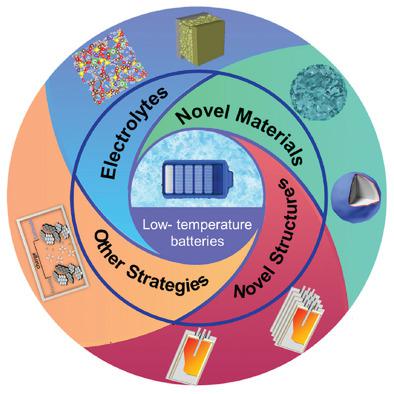当前位置:
X-MOL 学术
›
Adv. Mater.
›
论文详情
Our official English website, www.x-mol.net, welcomes your
feedback! (Note: you will need to create a separate account there.)
Critical Review on Low-Temperature Li-Ion/Metal Batteries
Advanced Materials ( IF 27.4 ) Pub Date : 2021-12-02 , DOI: 10.1002/adma.202107899 Nan Zhang 1, 2 , Tao Deng 2 , Shuoqing Zhang 1 , Changhong Wang 2 , Lixin Chen 1 , Chunsheng Wang 2 , Xiulin Fan 1
Advanced Materials ( IF 27.4 ) Pub Date : 2021-12-02 , DOI: 10.1002/adma.202107899 Nan Zhang 1, 2 , Tao Deng 2 , Shuoqing Zhang 1 , Changhong Wang 2 , Lixin Chen 1 , Chunsheng Wang 2 , Xiulin Fan 1
Affiliation

|
With the highest energy density ever among all sorts of commercialized rechargeable batteries, Li-ion batteries (LIBs) have stimulated an upsurge utilization in 3C devices, electric vehicles, and stationary energy-storage systems. However, a high performance of commercial LIBs based on ethylene carbonate electrolytes and graphite anodes can only be achieved at above −20 °C, which restricts their applications in harsh environments. Here, a comprehensive research progress and in-depth understanding of the critical factors leading to the poor low-temperature performance of LIBs is provided; the distinctive challenges on the anodes, electrolytes, cathodes, and electrolyte–electrodes interphases are sorted out, with a special focus on Li-ion transport mechanism therein. Finally, promising strategies and solutions for improving low-temperature performance are highlighted to maximize the working-temperature range of the next-generation high-energy Li-ion/metal batteries.
中文翻译:

低温锂离子/金属电池的批判性审查
锂离子电池 (LIB) 凭借在各种商业化可充电电池中的最高能量密度,刺激了 3C 设备、电动汽车和固定式储能系统的使用激增。然而,基于碳酸亚乙酯电解质和石墨阳极的商用锂离子电池的高性能只能在-20℃以上才能实现,这限制了它们在恶劣环境中的应用。在此,对导致LIBs低温性能差的关键因素进行了全面的研究进展和深入的理解;整理了阳极、电解质、阴极和电解质-电极界面所面临的独特挑战,特别关注其中的锂离子传输机制。最后,
更新日期:2021-12-02
中文翻译:

低温锂离子/金属电池的批判性审查
锂离子电池 (LIB) 凭借在各种商业化可充电电池中的最高能量密度,刺激了 3C 设备、电动汽车和固定式储能系统的使用激增。然而,基于碳酸亚乙酯电解质和石墨阳极的商用锂离子电池的高性能只能在-20℃以上才能实现,这限制了它们在恶劣环境中的应用。在此,对导致LIBs低温性能差的关键因素进行了全面的研究进展和深入的理解;整理了阳极、电解质、阴极和电解质-电极界面所面临的独特挑战,特别关注其中的锂离子传输机制。最后,











































 京公网安备 11010802027423号
京公网安备 11010802027423号